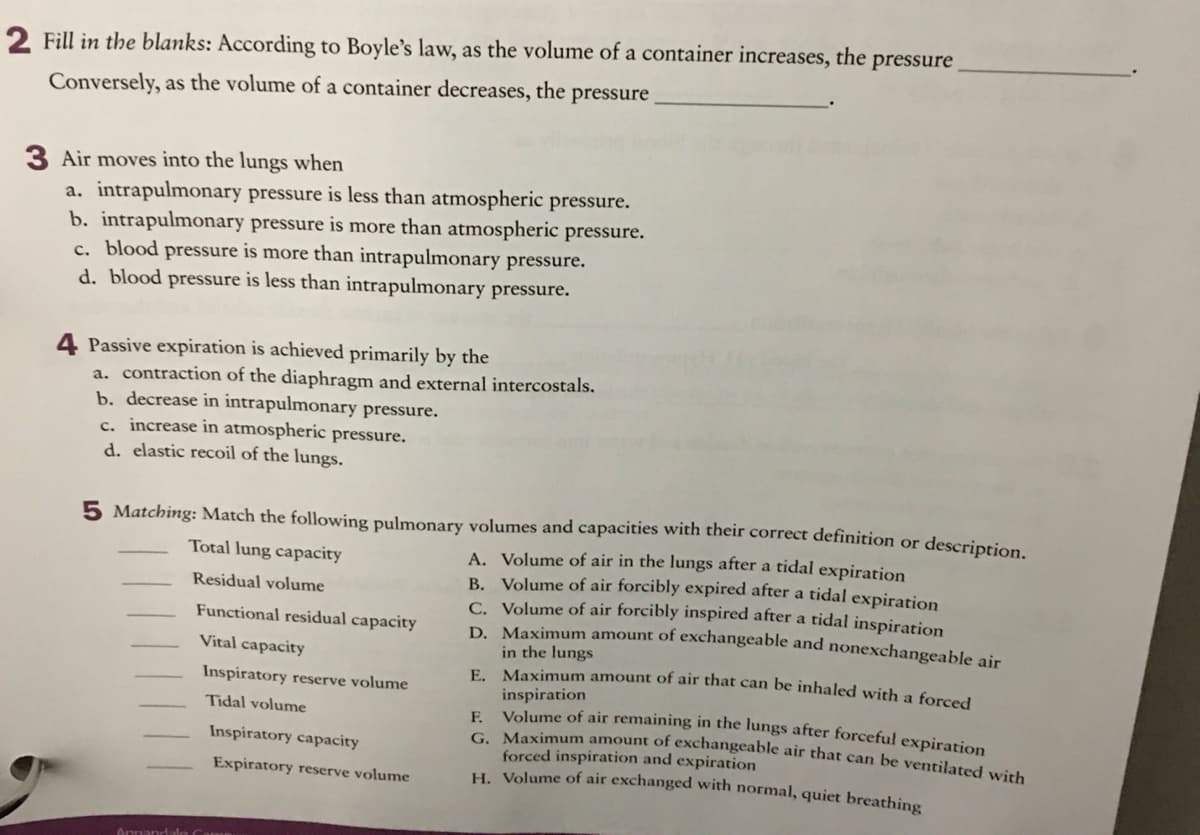Fill in the blanks: According to Boyle's law, as the volume of a container increases, the pressure Conversely, as the volume of a container decreases, the pressure B Air moves into the lungs when a. intrapulmonary pressure is less than atmospheric pressure. b. intrapulmonary pressure is more than atmospheric pressure. c. blood pressure is more than intrapulmonary pressure. d. blood pressure is less than intrapulmonary pressure. 4 Passive expiration is achieved primarily by the a. contraction of the diaphragm and external intercostals. b. decrease in intrapulmonary pressure. c. increase in atmospheric pressure. d. elastic recoil of the lungs.
Fill in the blanks: According to Boyle's law, as the volume of a container increases, the pressure Conversely, as the volume of a container decreases, the pressure B Air moves into the lungs when a. intrapulmonary pressure is less than atmospheric pressure. b. intrapulmonary pressure is more than atmospheric pressure. c. blood pressure is more than intrapulmonary pressure. d. blood pressure is less than intrapulmonary pressure. 4 Passive expiration is achieved primarily by the a. contraction of the diaphragm and external intercostals. b. decrease in intrapulmonary pressure. c. increase in atmospheric pressure. d. elastic recoil of the lungs.
Basic Clinical Lab Competencies for Respiratory Care: An Integrated Approach
5th Edition
ISBN:9781285244662
Author:White
Publisher:White
Chapter15: Humidity And Aerosol Therapy
Section: Chapter Questions
Problem 10SEPT
Related questions
Question

Transcribed Image Text:F. Volume of air remaining in the lungs after forceful expiration
2 Fill in the blanks: According to Boyle's law, as the volume of a container increases, the pressure
Conversely, as the volume of a container decreases, the pressure
3 Air moves into the lungs when
a. intrapulmonary pressure is less than atmospheric pressure.
b. intrapulmonary pressure is more than atmospheric pressure.
c. blood pressure is more than intrapulmonary pressure.
d. blood pressure is less than intrapulmonary pressure.
4 Passive expiration is achieved primarily by the
a. contraction of the diaphragm and external intercostals.
b. decrease in intrapulmonary pressure.
c. increase in atmospheric pressure.
d. elastic recoil of the lungs.
5 Matching: Match the following pulmonary volumes and capacities with their correct definition or description
A. Volume of air in the lungs after a tidal expiration
B. Volume of air forcibly expired after a tidal expiration
C. Volume of air forcibly inspired after a tidal inspiration
D. Maximum amount of exchangeable and nonexchangeable air
in the lungs
E. Maximum amount of air that can be inhaled with a forced
Total lung capacity
Residual volume
Functional residual capacity
Vital capacity
Inspiratory reserve volume
inspiration
Tidal volume
G Maximum amount of exchangeable air that can be ventilated wirh
forced inspiration and expiration
H. Volume of air exchanged with normal, quiet breathing
Inspiratory capacity
Expiratory reserve volume
Annandalo
Expert Solution
This question has been solved!
Explore an expertly crafted, step-by-step solution for a thorough understanding of key concepts.
This is a popular solution!
Trending now
This is a popular solution!
Step by step
Solved in 2 steps

Knowledge Booster
Learn more about
Need a deep-dive on the concept behind this application? Look no further. Learn more about this topic, biology and related others by exploring similar questions and additional content below.Recommended textbooks for you

Basic Clinical Lab Competencies for Respiratory C…
Nursing
ISBN:
9781285244662
Author:
White
Publisher:
Cengage

Biology 2e
Biology
ISBN:
9781947172517
Author:
Matthew Douglas, Jung Choi, Mary Ann Clark
Publisher:
OpenStax

Biology: The Dynamic Science (MindTap Course List)
Biology
ISBN:
9781305389892
Author:
Peter J. Russell, Paul E. Hertz, Beverly McMillan
Publisher:
Cengage Learning

Basic Clinical Lab Competencies for Respiratory C…
Nursing
ISBN:
9781285244662
Author:
White
Publisher:
Cengage

Biology 2e
Biology
ISBN:
9781947172517
Author:
Matthew Douglas, Jung Choi, Mary Ann Clark
Publisher:
OpenStax

Biology: The Dynamic Science (MindTap Course List)
Biology
ISBN:
9781305389892
Author:
Peter J. Russell, Paul E. Hertz, Beverly McMillan
Publisher:
Cengage Learning

Human Physiology: From Cells to Systems (MindTap …
Biology
ISBN:
9781285866932
Author:
Lauralee Sherwood
Publisher:
Cengage Learning

Cardiopulmonary Anatomy & Physiology
Biology
ISBN:
9781337794909
Author:
Des Jardins, Terry.
Publisher:
Cengage Learning,

Anatomy & Physiology
Biology
ISBN:
9781938168130
Author:
Kelly A. Young, James A. Wise, Peter DeSaix, Dean H. Kruse, Brandon Poe, Eddie Johnson, Jody E. Johnson, Oksana Korol, J. Gordon Betts, Mark Womble
Publisher:
OpenStax College